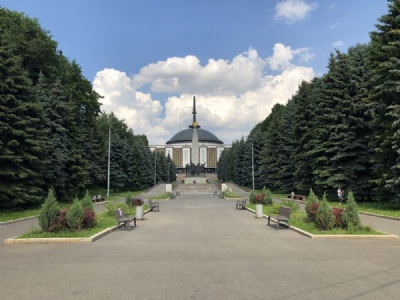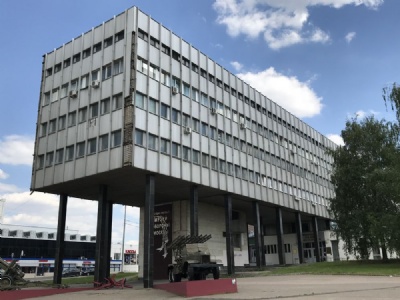Moscow
When Hitler invaded the Soviet Union without warning on June 22, 1941, one of the targets was the capital Moscow. In Moscow, the Soviet leadership was located and it was there that the embalmed body of the Bolshevik ancestor Lenin lay in his mausoleum in the Red square. The German armies advanced rapidly over the Soviet steppe and reaped great success in their advance. Hundreds of thousands of Soviet prisoners of war were taken along the way but somehow the Soviet Red army managed to come up with new reserves and fill the gaps. The German supply lines became stretched, which meant that the advancing armies did not get the material supply they needed quickly enough. Cut-off Soviet units were transformed into Partisan units and attacked both supply lines and German units in the back.
At the beginning of October 1941, the German armies stood about 300 kilometres from Moscow. The Germans launched the operation Typhoon as the attack on Moscow was called. However, problems arose when the Soviet roads that consisted of gravel/soil became muddy in the autumn rains and then the winter came with temperatures down to minus 35 degrees, plus snow and wind. When Soviet leader Joseph Stalin received reliable information that Japan did not plan to attack the Soviet Union from the east, reinforcements could be released from the eastern front and deployed at the defense of Moscow. In December 1941, the German armies stood no more than about thirty kilometres from the Red square, but closer than that they did not come. The forces were exhausted and insufficiently equipped for one last push to take Moscow. Hitler reluctantly allowed the forces to retreat to recuperate and resume the offensive next spring.
Already in October 1941, Moscow began to prepare for the German attack. The civilian population was mobilised to build defence positions around the city in the event of direct attacks or pincers attacks from several directions. Lenin’s embalmed body was brought eastward to safety. Likewise other treasures. The Soviet government prepared evacuation to Kuybushev about 850 kilometres southeast of Moscow. But no evacuation was needed, which, of course, became a great moral victory for Stalin.
In December 1941, residents of Moscow were able to see the artillery flames from german guns. The Germans had also carried out airstrikes against Moscow since July 1941, which increased when they moved closer to the city. Moscow, which at the time consisted largely of wooden houses, was therefore hit by severe fires. But unlike Leningrad, which was more or less besieged, Moscow had its back free and was thus able to bring supplies into the city. There was never any distress like that which afflicted Leningrad. In addition to sporadic attacks on the city, the Germans did not launch a new widespread offensive when spring came in 1942. The Germans (Hitler) had instead directed their offensive south towards the Caucasus. Moscow was therefore never conquered.
Current status: Museums/monuments (2010).
Location: 55°43'50.58' N, 37°30'17.35' E
Get there: Metro to Park Pobedy Station.
Follow up in books: Braithwaite, Rodric: Moscow 1941 (2006).
























Moscow is one of thirteen cities in the former Soviet Union, which was awarded the title Hero city for its sacrifices and suffering in what is called the Great patriotic war. A war fought between 1941 and 1945 against the fascist invaders from Germany. Moscow received the award in 1965. In the polarizing Soviet Union, it was this war that both people and leaders could unite around in a form of nationalism that was otherwise politically unthinkable in the communist Soviet Union. A war that involved enormous human and material suffering from which it took decades for the Soviet Union to recover.
The victory over Nazi Germany can rightly be said to be the greatest achievement of the Soviet Union, which has given the country a respect and recognition it might not otherwise have received. The Soviet Union (and present Russia) remembers the war with a pride expressed in both monuments and museums that radiates suffering, sacrifice and heroism in abundance. To an outsider, it may seem strange that a country and regime can parise itself without reservation, where all forms of objective objectivity (and criticism) are omitted. But on the other hand, it is difficult not to be impressed by the pride that both museums and monuments exude. But as much as it is a tribute to the history of the Soviet Union, it is as much a tribute to modern-day Russia as an heir to the Soviet Union. All history in Russia is state-controlled and the history shown is the history that benefits the present Russia and its leaders.
In Moscow there are several museums and monuments about the Great patriotic war. Just outside Red Square there is a majestic statue of Georgiy Zhukov on his horse. A statue erected after the fall of the Soviet Union when the new Russia sought for a new national identity that differed from the Soviet Union. In such cases, military leaders have always been well suited and what could then be better than the general most associated with the victory over Nazi Germany. Next to the statue are also other monuments that pay tribute to the patriotic war.
A relatively unknown museum is the State Museum of the Defense of Moscow which deals with the defense of Moscow. A better known museum is the Central Armed Forces Museum where a central part of the museum is the war against Nazi Germany. The most famous and lavish museum is undoubtedly the museum of the Great patriotic war. A huge museum that is just as much a monument. Mighty dioramas over different battles are interspersed with large halls and corridors where individual soldiers/generals are celebrated. In addition to indoor exhibitions, there are outdoor exhibitions spanning a huge area that takes time to explore. It is unarguably an impressive museum, but I’m also fully aware of its political militarism and glorification of the politics and leaders of today’s Russia.